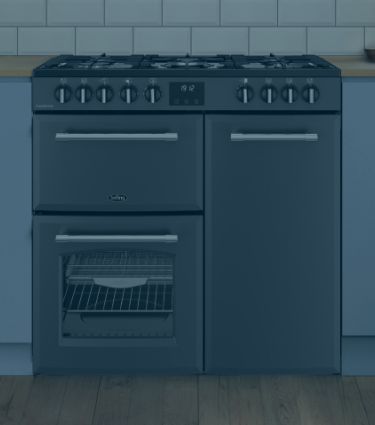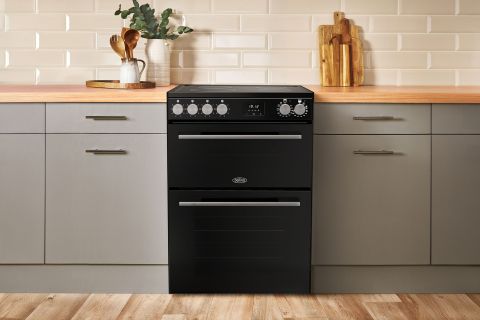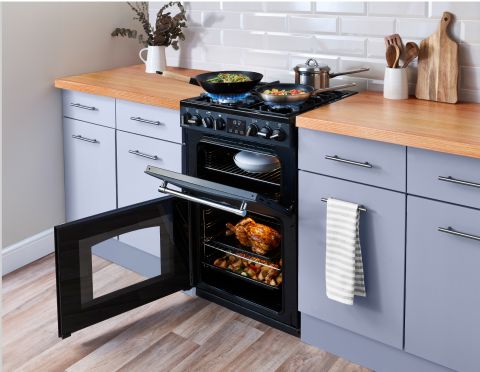
Range Cookers FAQs
- Dual-fuel and electric range cookers need to be hard-wired to a 32-amp fused spur cooker point.
- Gas range cookers are 13-amp rated and are supplied with a cable and 3-pin plug.
- Please note that dual-fuel and gas range cookers will also require a gas connection.
- The dual-fuel and gas range cookers have a ½ inch BSP parallel internal (female) gas connection in the rear-top-right-hand corner when looking at the appliance from the front.
- This gas connection is located approximately 565-745mm above floor level, depending on the model, when the cooker has been adjusted to a standard 900mm worktop height.
- Please note any gas appliance must be fitted by an approved Gas Safe engineer.
- Yes, the height of full-size range cookers can be adjusted between 900mm and 930mm to accommodate different heights of worktop - The installation guide will show the fitter how to adjust the height of the levelling feet on the range cooker.
- For safety reasons, it is important that the hotplate of the cooker is not lower than the adjacent worktops to prevent heat damage to the worktops.
- Dual-fuel range cookers (gas hobs with electric ovens) can be converted from natural gas to LPG.
- The LPG conversion kit can be ordered as an optional extra. Please contact us for more information.
- Gas range cookers (gas hobs with gas ovens) cannot be converted from natural gas to LPG.
- Please use pans with a base diameter of between 100mm and 250mm.
- Use pans with smooth, flat bases for optimal stability and heat distribution.
- Always place the pan centrally over the burner to ensure even heating and efficiency.
- Make sure the flames do not extend beyond the edge of the pan to prevent heat loss and possible damage.
- Please use pans with a base diameter of at least 145mm.
- Please ensure that the base of the pan is smooth, flat and magnetic across the diameter of the base.
- You may hear some soft clicking when the induction coil is switched on or off, and some soft buzzing relating to the electrical current creating heat in the pan.
A crackling sound when using your induction hob is normal in some cases.
Here’s how to minimise it:
- Make sure the base of the pan and the ceramic glass are completely dry. Moisture can cause a crackling sound during operation.
- Noises may be more noticeable at higher power levels. Lowering the power setting can reduce the sound.
- The type of pan you use matters. Pans with a higher amount of magnetic material in their base tend to be quieter.
- Yes, this is perfectly normal and will not affect cooking results.
- Induction hobs work differently from ceramic hobs as they use induction coils rather than heating elements. These coils generate a magnetic field that heats the pan directly through friction in its magnetic base.
- The hob’s electronics pulse the power on and off to maintain the selected power level:
- At lower power settings, the coil is on for shorter periods and off for longer periods.
- At higher power settings, the coil is on for longer periods and off for shorter periods.
- This process ensures the pan does not overheat and that the requested power level is maintained, delivering consistent cooking performance.
- Some touch-control timers feature a child-lock function.
- Please check if there is a padlock symbol showing on the display.
- If so, the child-lock will need to be deactivated.
- If the middle timer key has a circular arrow with the word ‘menu’, touch and hold the plus key for about 10 seconds until the padlock symbol disappears.
- For further information, please consult the user manual for your product.
- Yes, this is normal.
- Approximately 60 seconds after the last touch of a timer key, the timer display will dim a little.
- This is an energy-saving function.
- Pressing any timer key will brighten the timer display again.
- Ensure the cooker is turned on at the wall.
- If the timer display is flashing, the correct time of day will need to be set before the oven will function.
- On some models, the timer needs to be set to manual mode, often indicated by the word ‘Man’ in the display.
- Timers with 3 Touch keys (with ‘menu’): Press the middle menu button twice until ‘Man’ shows steadily on the display.
- For multi-functional ovens, choosing a cooking function (e.g., fan oven) and setting a temperature (e.g., 180°C) is needed to activate the oven.
This is normal.
- The ovens are very well insulated to keep more heat in during cooking for better cooking results with less wasted energy.
- After cooking, the cooling fan will run for longer than on previous models to help the appliance cool down to a low temperature (of around 45° C) and to keep the exterior parts of the cooker cooler for additional safety.
- The cooling fan may run for around 1 hour after cooking has finished, and this is normal.
- Don't worry, the cooling fan does not use much electricity (less than a tenth of a unit of electricity per hour).
- Please do not switch the cooker off at the wall before the cooling fan has stopped completely.
- While the fan runtime is part of the product's standard design and is working as expected, we want to make sure you're completely satisfied.
- We can offer an optional free modification to relevant models.
- This change allows the cooling fan to start immediately when the grill is turned on, and to stop sooner after cooking, reducing the fan runtime to around 30 minutes, to allow efficient cooling without compromising safety or performance.
- For more information, please contact our customer care team on 0344 815 3746.
- No, cooling fans consume very little electricity, so you don’t need to worry about energy usage.
- Yes, follow these steps :
- Switch the product off at the wall - Remove the shelves and any baking trays or tins from the oven.
- Unscrew the lamp cover.
- Most recent models use a G9 halogen bulb (part number 082650920) which pulls out from the lamp holder. However, bulb types can vary between models and so please always replace an old bulb with one of equivalent type.
- Push the new bulb into position and replace the lamp cover .
- Switch the product back on at the wall and set the time of day on the timer.
NB: Please remember that light bulbs are consumable items which are not covered under the manufacturer’s warranty.


